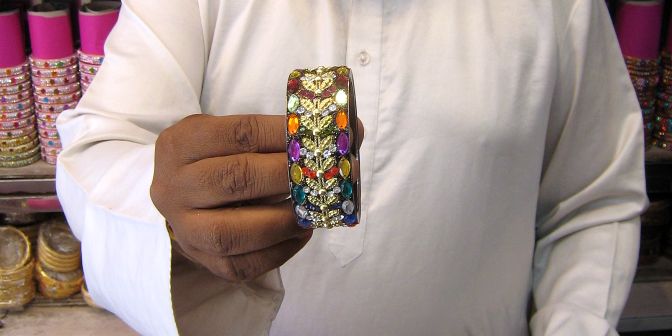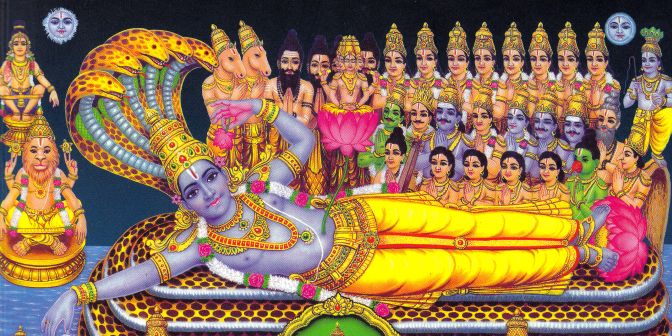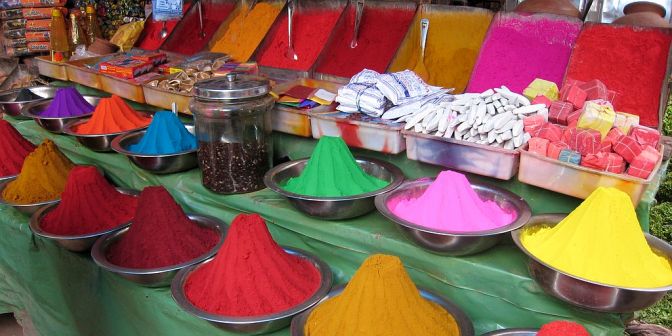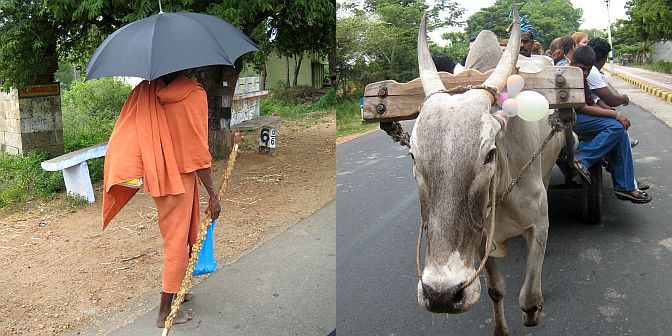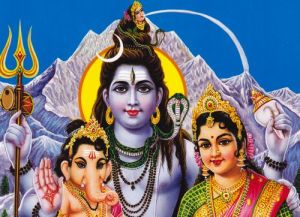Pastel Buddha, Sikh pudding and Jain disappointment; a gallery of marvels and a market of gems: cricket and Mecca, glowing fruit and perfumed wrists and begging without hands.
On Thursday I moved to the Hotel Rajmata in central Hyderabad for my remaining four nights in town. About NZ$20 per day for a large twin room with TV and bathroom, sheets a bit grubby, the Times of India shooting under my door each morning. Continuing my religious education, from here I visited a number of sacred sites. (See my Hyderabad photos here.)
I climbed a winding lane to the Birla Mandir temple, built from white marble in 1976. A dying red ball of sun flickered over the sea and artificial lake below, turning the sky pastel pink-blue behind the slim 17.5m Buddha statue on its miniature island, which I later ferried to. Carved stone panels cited Moses, Jesus, Confucius, Sai Baba, as well as Hindu scriptures. The compulsory shoe, bag and camera deposit stated “Free Service – Give No Tips”, so the elderly attendant requested “change”.
I draped my pocket sweat cloth over my head to enter a Sikh gurudwara (similar to one in Bangalore I described here). A hefty turbaned attendant woke from his slumbers and approached. I feared I had caused offence, but was given a handful of sacred karkah pudding, prepared while reciting their scriptures and offered to all visitors irrespective of religion or caste.
I found my first Jain temple tucked away in the buzzing Sultan Bazaar. Rice grains were spread on the floor in their reverse-swastika symbol. No English information, but cartoons on the walls illustrated stories I recognised from our Jainism lecture (see here). Books lay in offering before one stone idol, their covers smeared with the same paste worshippers anoint themselves with. From a shrine on the roof I photographed the bazaar below. Before leaving the hotel I’d switched my leather belt (forbidden in strict Jain temples) for a synthetic one, but was disappointed that no one checked, and that I didn’t see any Jain monks wearing gauze masks to avoid breathing insects.
Hyderabad was ruled by the Moslem Nizams until 1948, and the Salar Jung museum contains their collection of world art. Signs were in English, Hindi, Telegu (the local state language), and Urdu (slightly modified Arabic script). The day I was there, 14 November, was the birthday of Nehru, the first prime minister of India. He loved kids so it’s also Children’s Day. The museum swarmed with uniformed lasses and lads, the latter keen to shake my hand.
There were many wonders here. An all marble “Veiled Rebecca” – I first thought the veil was cloth. A mat woven from ivory threads. Silver elephant ornaments: ear and ankle rings, necklaces, forehead plates. Paintings of the Moghul ruler Akbar hunting with his hawk, and the sword of the last emperor Aurangzeb. The Japanese art shared a certain sparse beauty with Muslim calligraphy, of which one style, said a label, came from a dream of a heron. It all gave a taste of the city’s former elegance.
The city’s icon is the Charminar (“four towers”), a square tower with 56 m high corner minarettes, built in 1591 to mark the end of an epidemic. It’s still an icon of ill-health, best known on packets of Charminar cigarettes. From the top I admired the huge Mecca mosque silhouetted against the twilight, while feeling a little uneasy as others pushed past – there is only a one-foot-high stone wall between you and the swirling hustle below.
The Charminar is surrounded by a labyrinth of small shops and markets. I found a street of smiley Muslims selling khowa, the milk powder base for Indian sweets. “Chicken centres” with caged birds. Water pumped from hand-wells. Square-inch silver foil was hammered flat between book pages. Tailors re-stitched shirts, feet pedalling their sewing machines. I tried to distinguish smells of different samples dabbed on my hand at Chunilal Dayal Das Perfumers: House of Indian Attars, established 1885.
I must have given my country and name dozens of times. Upon learning I’m from NZ, most mention cricket or cricketers like Stephen Fleming and Richard Hadlee (unlike in Korea a few years ago, where people knew the Lord of the Rings movies). Cricketing knowledge would facilitate conversation but is an interest I lack. Until recently the only Flemings I knew were author Ian and pharmacologist Alexander.
Jewellers’ counters sparkle like Aladdin’s Cave. On the street, baskets display billions of glittering bangles on pink rolls. Even poor wrists jangle four or more silver bracelets. In the “Moin Bangles Centre, Specialists in Immitation Stone Bangles and Jewellery”, the owner, white robed and capped, posed for me with fingers dangling inch-wide bangles encrusted with glass gems. I purchased one. A guy on top of a bus lifted dangling power lines snagging its roof rack. Several kids asked to see NZ coins – I must bring some next time.
In a vegetable market, between weighing pans, heaped produce and foraging goats, sat a lady robed in black with her face and even eyes completely veiled. She cried out for alms, with one beseeching hand malformed like a shrunken foot. Somehow this faceless beggar disturbed me more than others. To give or not to give? Many beggars apparently choose to sponge off tourists – it’s more lucrative than a productive occupation (especially, no doubt, for pretty young women with babies), or are fuelling addictions. But some are still missing hands, or drag themselves along on trolleys trailing deformed legs. Apart from a few slices of bread from the loaf I often carry for safe snacking, I haven’t given to beggars. I’m thinking I should donate to India when I get back, via World Vision or the like, hopefully producing more lasting change for the truly needy than any coins I might give here.
After dark, geometrically-stacked spheres of bright fruit glow under bare electric bulbs. A line of Muslim calendars, with Arabic script and pictures of the cubic black Kaaba in Mecca, hangs above a row of Hindu gods and gurus. I bought cards for the Muslim Eid festivals that end the fasting and pilgrimage months, and a wall-hanging with pictures of minarets and palm trees, “Muhammed” and “Allah” written in Arabic. A friendly Muslim store-keeper told me the holy names should be held in the right hand by my heart, not swung below my waist in the left. An outstandingly honest auto-rickshaw driver I approached directed me to cross a bridge (through smoke from smouldering litter on the unkempt river banks) and catch a bus back to my hotel instead.
See how the speckled sky burns like a pigeon’s throat,
Jewelled with embers of opal and peridote.
See the white river that flashes and scintillates,
Curved like a tusk from the mouth of the city-gates.
Hark, from the minaret, how the muezzin’s call
Floats like a battle-flag over the city wall.
From trellised balconies, languid and luminous
Faces gleam, veiled in a splendour voluminous.
Leisurely elephants wind through the winding lanes,
Swinging their silver bells hung from their silver chains.
Round the high Char Minar sounds of gay cavalcades
Blend with the music of cymbals and serenades.
Over the city bridge Night comes majestical,
Borne like a queen to a sumptuous festival.
Nightfall in the City Of Hyderabad
Sarojini Naidu
